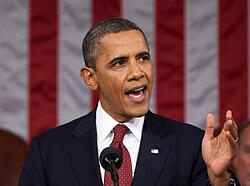 In last night's State of the Union address President Barack Obama cited employment data in challeging U.S. businesses to improve the domestic manufacturing outlook.
In last night's State of the Union address President Barack Obama cited employment data in challeging U.S. businesses to improve the domestic manufacturing outlook.
"Our first priority is making America a magnet for new jobs and manufacturing," said President Obama mid-way through the address.
But how ready are regional markets for scaling up laboratories, factories, and distribution supply chains?
How many new jobs can be created by directing Federal budget priorities to steer more resources into big public projects? Or to supporting more private manufacturing interests?
Will President Obama's call be heeded by the current Congress? And politics aside -- how quickly can manufacturing capacity be expanded nationwide?
I am inherently optimistic. At the same time, I've lived in two of the three regions that the President cited last night in the State of the Union address, so I'm very aware of regional demographic and economic wrinkles:
-- In the Midwest (Illinois, Indiana, Michigan and Minnesota, aka, the 'Rust Belt,' formerly the "Iron Belt).
-- In California (the Agricultural and High-Technology Belts).
During the time I lived in Minnesota, in the early 2000s, I witnessed the gradual downsizing of a major Ford plant near the Mississippi River in St. Paul. The workers at that Twin Cities Assemblies plant had been producing pick-up trucks, cars, and heavy equipment for nearly a century.
Their operation had survived companywide closures in the thirty year period in which Ford's market dominance was challenged by a slew of foreign and domestic automakers. Decades of poor business decisions making had led to inefficiencies of systems, innovation and vision. All ultimately led Ford to close the plant, throwing hundreds of workers out on the street in 2011.
I followed the story of the Twin Cities Assemblies Plant's closing from afar, but I felt the shame and indignation of the workers acutely.
In California, the Silicon Valley technology industry grew from the aerospace companies that sprouted there during the World War II years; that sector was bolstered by nimble science brains at Stanford, San Francisco State University, U.C. Berkeley.
By the time I started college in San Francisco in the early '80s, 'the Valley" was home to Apple, Hewlett-Packard and other leading technology firms that would remake information industries during the ensuing decades. The 'dot com boom' of the late '90s, was followed swiftly by a 'dot com bust' by 2003, signaling a market correction that few had foreseen.
In the past five years, the tech sector in the Silicon Valley has come roaring back, aided in no small part by the North American Free Trade Agreement (NAFTA) signed during President Bill Clinton's administration.
That agreement made it easier for businesses like Apple to set up manufacturing operations overseas, where few union contracts and government regulations impact wages and worker saftey measures. But it wasn't exactly great for the wide population, as corporations innovated in ways that created highly-specialized jobs domestically, but outsourced assembly processes that required large numbers of low-skilled workers.
So here is what I want to know about President Barack Obama's blue-sky call for reinvigorating American manufacturing:
- What kind of innovative disruption to corporations' culture, systems and economic models will be required for 'old line' companies like Ford, Caterpillar and other 'Rust-belt' powerhouses to resume large-scale domestic manufacturing again?
- Can production lines be stream-lined and made cost efficient? If so, will it mean fewer jobs are created?
- What can Silicon Valley 'tech-preneurs' and corporate leaders do differently to create more jobs for a wider pool of workers than just programmers, developers, and administrators. Can the tech industry lead the way in creating more jobs for marketing and communications workers?
- Can the great recession be turned around by enabling U.S. businesses to produce more consumer goods if significant numbers of customers cannot afford to purchase more inventory?
- Does the President or Congress have a significant role in helping Silicon Valley groups expand their domestic manufacturing capacity?
Unlike some other major American automakers in recent years, Ford has rebounded splendidly from the recession, although some of its overseas markets continue struggling. What are the next steps for the Obama Administration and Congress to now push forward to increase manufacturing jobs quickly in the Iron Belt -- aka the 'Rust-belt?"
And in the Silicon Valley, the debate over immigration carries weight: foreign workers in need of worker visas have led some tech company leaders to push the president to create special designations-- what will that mean for domestic workers in that market?
I will watch closely the official responses to President Obama's address -- especially from the corporate and political leaders in my former home regions.
How about you? Did you hear anything in President Obama's State of the Union Address that speaks to your experience?
Let us know!
For information on using market research to make educated business decisions and move into new markets, download our free white paper.
Cheers,

Amy Alexander
Senior Writer/Content Editor
Official White House Photo by Pete Souza


